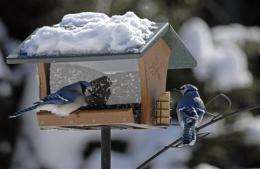Birders prepare for count mindful of mass die-offs

(AP) -- Thousands of citizen-scientists across North America are getting out their tally sheets for the 13th annual Great Backyard Bird Count, a usually festive weekend given a more serious edge after the mass deaths of thousands of birds in the South this winter.
The National Audubon Society and Cornell Lab of Ornithology sponsor the count. They hope to have more than 100,000 backyard counters for the Feb. 18-21 effort this year, especially after public attention on threats to birds was heightened when blackbirds fell from the sky in Arkansas on New Year's Eve.
"An isolated event such as the dead birds in Arkansas may be within the range of normal ups and downs for an abundant species like the red-winged blackbird," said Janis Dickinson, director of citizen-science at the Cornell lab in Ithaca. "But the count can serve as an early warning system for worrisome declines in bird populations that result from more widespread problems."
The deaths in Arkansas - where officials believe the birds were spooked by fireworks - and subsequent bird kills in Tennessee, Kentucky and Louisiana aren't believed to be connected or a sign of widespread contagion.
The backyard count is one of a number of citizen-science projects that gather data on birds. Others are Aubudon's Christmas Bird Count, the North American Breeding Bird Survey and Cornell's Project FeederWatch and NestWatch.
"One thing we anticipate this year is the presence of birds from the boreal forest of Canada, such as common redpolls, at feeders in the Northern U.S.," said Cornell's Miyoko Chu. "They stay up North when they can find enough seeds, but this year birders are seeing them at their feeders."
In the Northeast, where much of the landscape is buried under deep snowdrifts, American robins are likely to be scarce, based on data from previous years showing they tend to avoid areas with heavy snow cover, Chu said. While robins are traditionally considered harbingers of spring, many winter up north but stick to thickets where they feed on dried berries and fruit.
Participants, from novice to expert birdwatchers, keep track of the number of birds they see of each species in their yards or local parks during the four-day count and report the data online at http://www.birdcount.org .
"The exciting thing about Great Backyard Bird Count data is that it provides a big picture almost instantaneously," Chu said. "People can watch on the website as reports come in."
Past Backyard Bird Counts showed a drop in the numbers of American crows since 2003, coincident with the first widespread outbreaks of West Nile virus. The signal was confirmed by the more intensive Breeding Bird Survey.
Maps from the count have captured the paths of sandhill cranes migrating from Arizona and New Mexico to breeding grounds in Nebraska, demonstrating whether they had an early or later migration in a particular year, Chu said. Bird count maps also show the spread of new species such as the Eurasian collared dove, which was introduced from the Bahamas in the 1970s and spread from eight states in the 1999 backyard count to 39 states and Canadian provinces a decade later.
Counters in Arkansas aren't expecting that the birds lost on New Year's Eve - about 5,000 specimens of the abundant red-winged blackbird - will affect their results, but they acknowledge the die-off is on their minds.
"When it comes to trends in bird populations, you've got to look at the long term," said Dan Scheiman of Audubon Arkansas. "That's what's so great about the Backyard Bird Count; it can produce long term trends over large scales."
Lois Geshiwlm and Nancy Castillo, owners of Wild Birds Unlimited in Saratoga Springs, participate in the backyard bird count and several other citizen-science programs each year from their log home surrounded by feeders stocked with seed, suet, peanut butter and other treats.
"I like to think of the Great Backyard Bird Count as the every-person's science project," Castillo said. "It's the easiest one for the real casual birdwatcher to step in for one day a year, or four days a year, to count the birds."
©2010 The Associated Press. All rights reserved. This material may not be published, broadcast, rewritten or redistributed.















